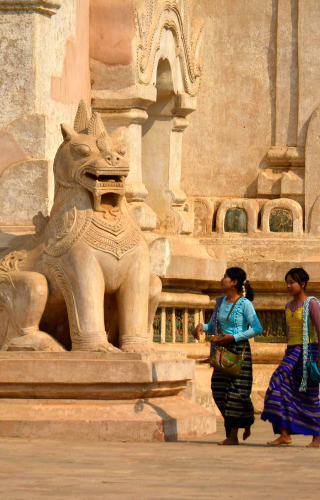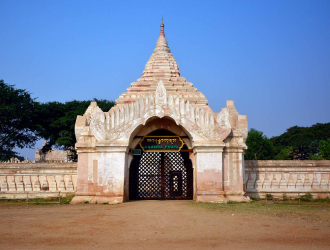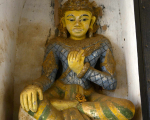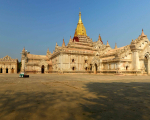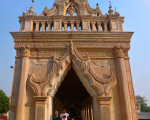Central Myanmar receives little rainfall and summer months are long and severe. The only succour in the hostile landscape is the Irrawaddy River, which originates in the Himalayan glaciers of Upper Burma and flows to the Bay of Bengal. The Irrawaddy floodplains support agriculture, the main source of livelihood for a majority of the population. By the second century CE, the region gave rise to walled settlements, collectively called the Pyu city-states (third to ninth century CE). Most powerful of these city-states was Sri Ksetra, one of the earliest urbanised regions in Southeast Asia. Sri Ksetra was an important entrepôt between China and India. In 107 CE, King Thamoddarit of Sri Ksetra established Arimaddanapura (meaning the city which tramples on enemies), and over the following centuries it emerged as a powerful kingdom in the region, known as Bagan (alternately Pagan).
In the eleventh century, King Anawratha (ruled 1044–1077 CE) established the Empire of Bagan by unifying the different kingdoms of the Irrawaddy valley under one political authority. This was the first true empire to emerge from Burma which would dominate Southeast Asia for the next 250 years. Guided by his guru, the venerable monk Shin Arahan, Anawratha vigorously promoted Theravada Buddhism throughout his empire. Anawratha is the first major temple-builder in Bagan’s history.
Anawratha was succeeded by his son Saw Lu. In 1084, Saw Lu was succeeded by his half-brother Kyanzittha (r. 1084–1112/3 CE). He continued the temple-building work of his father and consolidated Bagan’s dominant geopolitical position in the region. As ruler, Kyanzittha was a patron of Mon language and culture, and he also proselytised Theravada Buddhism in Southeast Asia. He did this by strengthening diplomatic relations with foreign countries, particularly India, where he is recorded to have sent a mission (around 1095 CE) to the Mahabodhi Temple at Bodhgaya to carry out restorations to the temple which marks the spot where Buddha attained enlightenment. Though he was an ardent Theravada Buddhist king, Kyanzittha was also influenced by Hindu political ideas and nature of kingship. Like Hindu rulers in India, he declared himself a chakravartin (universal ruler) and considered himself the earthly manifestation of Lord Vishnu.
Due to its proximity to India, Burma was greatly influenced by the Indian civilisation. India held a prominent place of reverence amongst the Burmese as the country where Gautam Buddha was born and where Buddhism flowered. However, Bagan’s contact with India was more than just a shared interest in Buddhism. There was long-established trade links between the two countries, and also with independent Arakan, which was located between Bengal and Burma. Ships set sail from ports dotted along India’s eastern coastline and they anchored at ports in Arakan or travelled upstream the Irrawaddy River directly reaching Bagan. Burma also had maritime contact with Sri Lanka, the Khmer Empire to the east, the Sri Vijaya Empire in the south and with China. The ships traded in goods, but also transported students, pilgrims, monks and scholars, who would come to India for higher education at famous mahaviharas (residential universities), particularly at Nalanda, Vikramshila, Jagaddala, Somapura, Odantapuri, and dozens of other sites scattered throughout the Indian subcontinent and Sri Lanka. Thus, Burma turned to India not only for religious inspiration, but also for cultural, economic, artistic and intellectual enrichment.
India had a predominantly Hindu-Buddhist culture till the eleventh century. However, as early as the tenth century, India’s western borders were facing frequent raids from the Ghaznavids based in Afghanistan. These raids had severe long-term consequences. By the early thirteenth century, the invasions were successful and resulted in the establishment of the Delhi Sultanate, which stretched from north India to the plains of Bengal. The great mahaviharas of the Indo-Gangetic plain were destroyed in a short span of time, never to revive again. The sacred Buddhist pilgrimage sites at Bodhgaya, Sarnath and Kushinagar were looted, desecrated and abandoned. Unable to withstand the loss of cultural sites and targeted as idolaters, Buddhism entered a phase of terminal decline in India.
The threat of Islamic persecution and loss of patronage from rulers forced Buddhists to flee India. Many sought refuge eastwards—in Burma. One delegation of eight monks met King Kyanzittha and told him of Nandamula cave, where they came from. The location of Nandamula has not been definitively identified. There is speculation the caves were located in the Himalayas, or refer to the Udayagiri caves in Odisha. Moved by their evocative description, Kyanzittha commissioned the building of a grand temple in Bagan to replicate the Nandamula caves—Ananda.
Ananda was originally named Anantapanna, meaning ‘infinite wisdom’. The temple was consecrated in 1090 CE. It is also possible that the shortened name Ananda is a corruption of the Nandamula caves or the historic personality Ananda, one of the principal disciples of Buddha. The influence of Indian ideas is visible in many design elements, from its North Indian style shikhara to the use of Hindu motifs like dwarapalas (gatekeepers), kumbhas (pots), chinthe (lion) and makaras (mythical sea creature). According to French epigraphist George Coedes (considered the father of Southeast Asian archaeology) the architect was buried alive (together with a child) to serve as protective guardian spirits, known as Natin Burma.
Ananda is a gu-style (derived from gupha, meaning cave) temple, where instead of having a single-chamber sanctorum—like in Hindu temples—the core of temple is a solid cube with niches cut into each face, featuring a colossal Buddha image. The hollow cave style is inspired not only by the Nandamula story, but also because Buddha himself lived and meditated in caves during his lifetime. All four Buddha images are standing on lotus pedestals, depicting particular mudras (hand gesture) and facing the four cardinal directions: Kassapa (south facing), Kakusandha (north facing), Konagamana (east facing) and Sakyamuni (west facing). The fifth Buddha of the present kalpa (cosmological time unit counted in billions of years)—the Maitreya Buddha—is not represented.
The four Buddhas housed at Ananda were born, preached and attained parinirvana in ancient India. Kassapa (Sanskrit Kasyapa) was born at Isipatana Deer Park, located close to Varanasi, in Uttar Pradesh. Kakusandha was born in Khemavati (modern name Gotihawa), in Lumbini zone, Nepal. Lumbini zone was also the birthplace of Konagamana (Sanskrit Kanakamuni), who was born in Sobhavati (modern name Nigalihawa) and Sakyamuni (Gautama Buddha), who was born at Lumbini. Due to the close proximity of these sites to each other, they were visited in 249 BC by Mauryan Emperor Ashoka, who erected sandstone pillars to mark the occasion. The sites were also visited in the seventh century by Chinese Buddhist monk and scholar Xuanxang, who recorded the geographic locations. In the nineteenth century, guided by Xuanxang’s descriptions and confirmed by inscriptions on the Ashokan pillars, the lost sites were rediscovered by the Archaeological Survey of India (ASI).
Ananda was patronized by successive rulers, and restorations were carried out in later periods. The original Konagamana and Sakyamuni images were destroyed by fire (they are made of teak wood) and were replaced in the eighteenth century in the Konbaung style. In the 1920s, the British added covered arcades on the west, south and northern approaches which provide shelter to shops. These arcades are built in a distinctly European style and look anomalous with the architecture of the rest of the temple complex. Over time, the main threat to the temple came not from invasions, but from nature. The temple has been repeatedly damaged by devastating earthquakes. In 1975, Bagan was hit by a severe earthquake and the most recent earthquake hit the region in 2016.
The historic connection Bagan had with India was reinstated when, in 2010, India and Myanmar signed an agreement, and the Indian government allocated Rupees 20 crore to ASI for restoration work at the Ananda Temple. The ASI has, in addition, restored several murals and pagodas that were damaged in the 2016 earthquake. Indian Prime Minister Narendra Modi personally visited Ananda Temple in 2017 to strengthen cooperation between India and Burma in culture and heritage conservation. While the temple celebrated its 900th anniversary in 1990, it is still an active temple visited by thousands of Buddhist devotees and tourists from all over the world, and is universally acclaimed as the chef-d'œuvreof Burmese architecture.
Bibliography
Coedes, George. The Indianized States of South East Asia. Edited by Walter F. Vella and translated by Susan Brown Cowing. Honolulu: East-West Center Press,1968.
Coedes, George. The Making of South East Asia. Translated by H.M Wright. London: Routledge & Kegan Paul, 1967.
